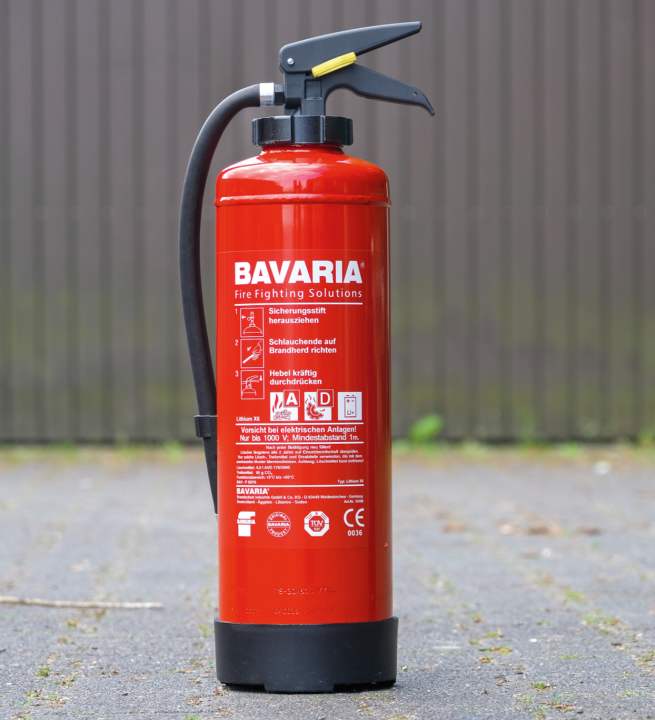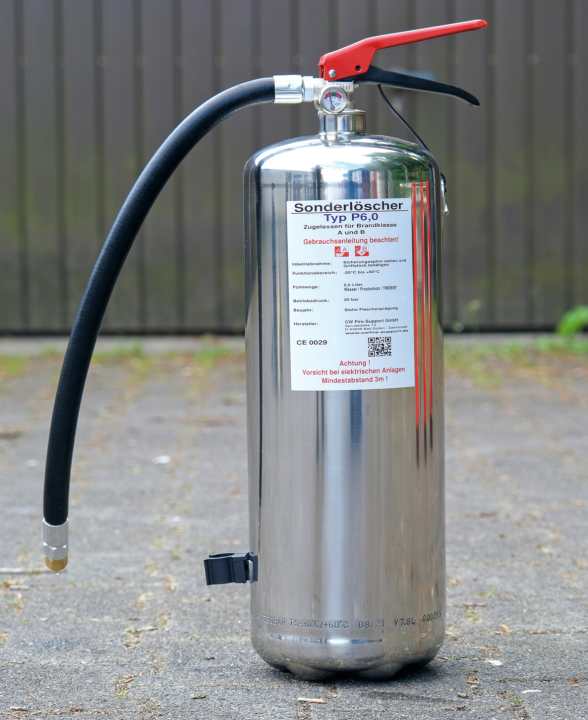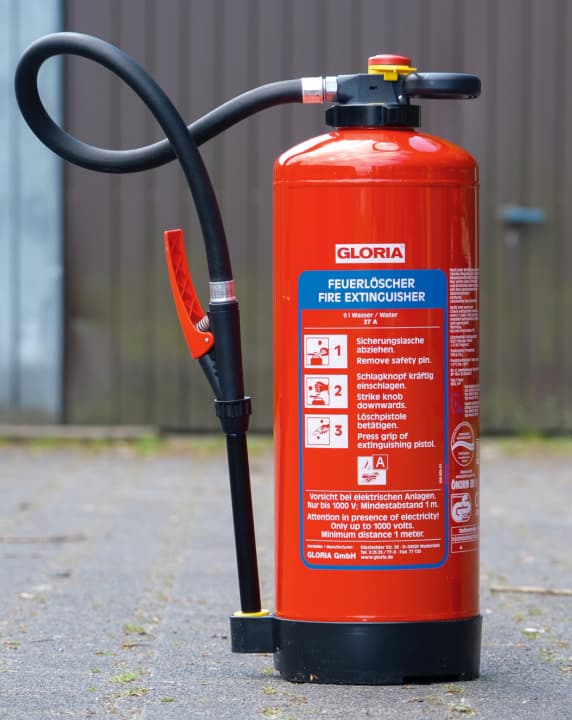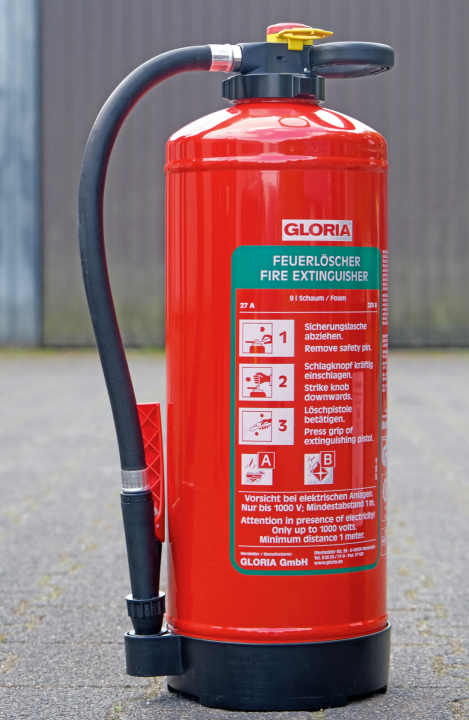





In this article:
Power storage systems with lithium technology are an integral part of everyday life. Whether mobile phones, laptops, tablets, cordless screwdrivers or e-bikes - lithium batteries are used everywhere. These batteries have also found their way on board, in portable equipment (tools, handheld radios), but also as consumer batteries. The advantages are clear: higher energy density than comparable lead-acid batteries and therefore a smaller design and less weight with the same or higher capacity. In addition, lithium batteries absorb charging current better, are more cycle-resistant and therefore last significantly longer. In addition, the technology has become increasingly affordable in recent years and is therefore becoming more and more attractive compared to heavy lead-acid batteries.
However, lithium batteries also have one major disadvantage, and that is the risk of fire. Lithium technology is considered to be very safe and the batteries come with control electronics, the so-called battery management system (BMS for short), which is designed to protect against overcharging or short circuits. However, if a lithium battery catches fire, it was previously virtually impossible to extinguish the fire. The only option is to let it burn down in a controlled manner, cover it with large quantities of sand or cool it down in a water bath to stop the chemical process of thermal runaway. None of these options are feasible on a boat.
This makes the development of special extinguishing agents for lithium batteries, which some manufacturers have recently launched, all the more pleasing.
Several fire extinguishers in the test
Tested our sister magazine YACHT Four extinguishers that are explicitly designed to extinguish burning lithium batteries. These include the Lithium X6 from Bavaria, the special extinguisher type P6.0 from CW Fire, the Pro-Line Water Lithium from Gloria and the G6 SDJ Gel model from Jockel. The Bavaria model is also suitable for fire class D, meaning it can also fight metal fires. The special extinguisher from CW Fire-Support was developed for emergency services to extinguish pyrotechnics (e.g. at football matches) and people who have caught fire as a result. It is available in a special design for carrying on the back. The conventional version is included in the test. The extinguisher from Gloria even comes with a specification that cells up to 1,200 watt hours can be extinguished with it.
The extinguishing agent quantity varies between five and nine litres for the test products. The extinguishing agents are also different: Bavaria uses AVD, CW Fire uses water and Trident, Gloria uses water and Imprex C and Jockel uses Firesorb PM01. It is not clear exactly what is behind the product names. The extinguishing agents are foamed with water or have a gel-like consistency. A key property of the additives is that they make the water content resistant to the extremely high temperatures of 1,500 degrees Celsius and more.
Extremely dangerous: extinguish a burning lithium battery with water
Extinguishing a burning lithium battery with water can be extremely dangerous. If the amount of water is not sufficient to cool the fire down, i.e. if it is only extinguished with a water mist, the water molecules can disintegrate due to the extreme heat. This leaves hydrogen and oxygen. Both are extremely flammable, so the fire would only be fuelled. This is why choosing the right extinguishing agent and avoiding the wrong one is so important.
But great caution is also required with the right extinguishing agent. This is because the burning battery is extremely explosive, with the individual cells sometimes flying metres away, producing large jet flames and extremely toxic smoke containing hydrofluoric acid, among other things. The more fully the battery is charged, the more energy is released and the more violent the fire. This is easy to visualise: A battery with one kilowatt hour of capacity (which is only about 83 ampere hours at 12 volts) can release 1,000 watts for one hour. If it delivers this energy in just 30 minutes, it can deliver 2,000 watts, 4,000 in 15 minutes, 8,000 in 7.5 minutes and 16 kilowatts in just under four minutes. This is equivalent to the energy of ten fan heaters, concentrated at one point.
If so much energy is released in a short time, this is accompanied by extremely high temperatures and large flames, and hydrogen is also produced, which burns explosively. This process is also known as thermal runaway.thermal runaway). Caused by a short circuit, mechanical damage or an error when charging the battery, a cell heats up until it catches fire, triggering the same process in the neighbouring cells. A chain reaction starts and simply cannot be stopped. This fire cannot be extinguished in the true sense of the word, as it is not dependent on a supply of oxygen.
Wait for comparability
The only chance is to interrupt the thermal runaway process by cooling it down considerably. This should prevent the fire from spreading to other cells and the ship. This is what the special extinguishing agents in our test devices are supposed to do. On the test site, we first let the battery ignited by the heating element ignite properly. High jet flames and individual explosions help us to estimate how many cells have already gone through. On board, of course, you would immediately start trying to extinguish the fire. For a better comparison, we wait until the thermal runaway is in full swing.
Clemens Widmayr, Managing Director of CW Fire and experienced firefighter, slips into protective clothing and operates the fire extinguishers. As a layman and without protective clothing, you shouldn't get too close to a blazing lithium battery.
The Lithium X6 from Bavaria immediately becomes a trial by fire for the helmet visor and firefighter jacket, as the cells simply continue to explode and fly around like projectiles. The extinguishing agent has no appreciable effect, so the test has to be cancelled after just over a minute. As the extinguisher only sprays the extinguishing agent about two metres, which the expert refers to as the throw range, you also have to venture dangerously close to the source of the fire when extinguishing it.
The situation is better with the products from CW Fire and Gloria. Although the Gloria extinguisher has a significantly higher extinguishing agent capacity of nine litres, it has the disadvantage that you have to get very close to the source of the fire. The special extinguisher from CW Fire-Support, on the other hand, has a throw range of up to eight metres. It compensates for the smaller quantity of extinguishing agent by being easy to dose. In this way, the flames can be extinguished with full force and individual smouldering cells can be kept in check with a reduced jet. This allows you to extinguish for quite a long time and avoids backfiring.
Always make an emergency call
However, this can never be completely ruled out with lithium batteries. This is because individual cells, which may be on the verge of leaking, can still exceed the critical temperature threshold minutes after the attempt to extinguish the fire and set the chain reaction in motion again. For this reason, an emergency call should always be made in the event of a battery fire, even if the fire appears to be under control. As soon as the battery is no longer smoking, it should also be removed from the ship. To be on the safe side, the fire brigade will store extinguished batteries in a cooling water bath even hours later.
Jockel's extinguisher started promisingly and the fire seemed to be extinguished after 1:59 minutes. At minute 4:45, however, flames suddenly flared up again and there was not enough extinguishing agent left to extinguish the back ignition. This meant that the fire could not be extinguished successfully. With fire extinguishers, the assessment can only take place between the extremes of extinguishing success or failure.
In an emergency, the only thing to do in the event of a re-ignition is to retreat and bring the crew and yourself to safety. At sea, the only option is to step into the life raft or dinghy. But when does the moment come when the fire has got out of control?
In the test, there were situations that would have been extremely dangerous for non-experts, particularly with the extinguishers that extinguished worse, such as the Lithium X6 model from Bavaria. And as much as we would have liked to hold the extinguishers in our own hands during the test, we were glad that an experienced fire protection expert with protective clothing took over this part. After all, high jet flames and exploding and shooting cells make the extinguishing attempt very dangerous. In an emergency, there is no protective clothing to hand and it is virtually impossible to get closer than three to four metres to the source of the fire.
A small sensation
The good news: some of the extinguishers tested can successfully fight the fire! This is even a small sensation, as it was previously considered hopeless. Nevertheless, the Test result must also be viewed critically: The test environment was very safe thanks to the exhaust air and armoured glass and offered unhindered access to the source of the fire. This is certainly not the case in an emergency. If the fire is only noticed late and the location is barely accessible, the flames will probably have already spread to the boat and it will not be possible to extinguish the fire safely. In addition, the jet flames and smoke below deck cannot spread upwards and hit the person with the extinguisher.
If incipient fires are discovered quickly, there is still a chance of extinguishing them successfully. Holger Flint from insurer Pantaenius advises that if you decide to attempt to extinguish a fire, you should approach the source of the fire as crouched as possible, as the smoke will eventually rise upwards below the ceiling of the lounge. In general, the high toxicity of flue gas should not be underestimated. When plastics burn, corrosive hydrochloric acid is formed when inhaled. Flue gas also contains a lot of carbon dioxide and carbon monoxide. However, burning lithium batteries also produce hydrofluoric acid, a toxin that is extremely toxic even on contact with the skin.
In this situation, experts advise against attempting to extinguish the fire, as the risk of injury is far too high. What's more, the extinguishers are all quite unwieldy and heavy. The special extinguisher from CW Fire is the only model that weighs less than ten kilograms. The inglorious front-runner is the Pro-Line Water Lithium from Gloria with an unwieldy 16.7 kilograms. However, at nine litres, it also has significantly more extinguishing agent in the tank.
In addition to handling, safe stowage must also be considered: Such a lump should not rumble through the cabin in rough seas, but must always be to hand in case of an emergency. On smaller boats, however, suitable space for secure stowage is likely to be rare.
Exclude causes of fire in advance
The top priority is therefore to rule out possible causes of fire beforehand. According to Holger Flint from Pantaenius, in the case of lithium batteries, these are the charging technology and fires in the periphery of the battery, which then lead to thermal runaway. If the energy store is full and the charger simply continues to charge, this can cause the battery to thermally runaway. The charging technology must therefore work, including the charger for 230 to 12 volts, the alternator and, ideally, the connected charge controller and solar charge controller. However, external batteries in the equipment on board should also only be charged using the power supply units recommended by the manufacturer.
This is where Rainer Daniel, Managing Director of Fisacon, comes in with his Raclan Box. The fireproof box holds up to two e-bike batteries (total capacity 1.7 kilowatt hours) and prevents the flames from spreading to buildings or boats in the event of a fire. The energy storage units are charged in the box, as it is the charging process that harbours the greatest risk. To keep the weight within limits, the box is made of so-called armoured wood. This is highly compressed beech, which is non-combustible and can withstand even powerful explosions.
In addition to faulty charging infrastructure, material defects or mechanical damage to the storage system can become a problem. The former are not recognisable, but the latter may be. So if the device or the battery has been damaged and the battery has visible damage to the housing, the only solution for safety reasons is to replace it.
Know which battery it is
The exact type of battery is also crucial for operational safety. Lithium batteries are just a generic term that covers various cell chemistries and designs. The exact designation then specifies which electrode materials and electrolytes are contained. NMC batteries are very common here. The abbreviation stands for nickel-manganese-cobalt-oxide.
Another common material combination is the lithium iron phosphate battery, or LiFePO battery for short. The differences in the materials used affect the energy density and also the operational safety. Lithium iron phosphate batteries are considered to be thermally safe, confirms Holger Flint. This is good news, as this cell chemistry is often used for consumer batteries on board.
However, especially in applications where weight and dimensions need to be minimised, cell types are used that have a higher energy density and are more likely to thermally run away in the event of faults in the charging technology. Although the technology is very safe, the energy storage systems are also extremely widespread. They can be found in every area of everyday life, and ten items of equipment with rechargeable batteries can easily be found on board. Even with smartphones, tablets, torches or head torches, power banks, handheld radios, drones and electric folding bikes, there are a considerable number of lithium batteries on every yacht. With safety at sea in mind, the thought of the worst-case scenario is no longer scaremongering.
If in doubt, an inspection of the electrical installation and charging infrastructure by a specialist can usually prevent the worst from happening. Especially with gadgets such as drones, in which batteries with a high energy density are installed, branded power supply units should be used for charging. It also makes sense to visually check the battery for damage. Fisacon's fireproof box can provide additional safety for bicycle batteries, which can also be particularly dangerous in the event of a fire due to their high capacity.
Fire extinguisher is used last
The fire extinguisher for lithium batteries is only the last line of defence when all other precautions have failed. And even if the test has shown that attempts to extinguish burning lithium batteries can be extremely dangerous, the right extinguisher may make all the difference at sea.
The only option if the attempt to extinguish the fire fails is to leave the boat. If the fire can no longer be extinguished with the fire extinguisher, the only option is to retreat to the dinghy or the life raft.
So is it worth buying a special extinguisher in the hopefully very unlikely event that a lithium battery catches fire? Even if safety should not be linked to money: The special extinguishers are not particularly cheap. The Gloria model costs just under 160 euros. It is also rather unwieldy. However, it should be borne in mind that the Gloria extinguisher also fulfils fire class A, i.e. it can extinguish solid burning materials, while the special extinguisher from CW Fire even fulfils A and B, i.e. it can also extinguish liquid burning materials.
It would therefore be possible to carry the extinguisher against lithium fires on board instead of the large foam extinguisher. This means that no additional space is required for storage. And in an emergency, the device can simply deal with one more cause of fire.
How it was tested
Rainer Daniel, Managing Director of Fisacon, has experience with the test ignition of lithium batteries and also has the appropriate test environment. This is because an extremely hot, potentially non-extinguishable fire that produces toxic gases can quickly become a risk for the testers. This is why the tests were carried out in a freight container with special ventilation and behind a pane of armoured glass by an experienced fire protection expert. The batteries all came from Swiss Post e-bikes, were fully charged and had a capacity of around 800 watt hours. They were ignited electrically with a heating element. The extinguishing attempt only started when the battery was on fire and around ten cells had already gone through. This ensured that the fire would not go out on its own and that all extinguishers had comparable conditions.
The extinguishing tests with the respective fire extinguisher showed how unpredictable a burning lithium battery is: It is impossible to predict when the next cell or several cells will go off at the same time. The cells can also fly several metres like projectiles. At 1,500 degrees Celsius, the extremely hot fire prohibits extinguishing with water mist, as the molecular structure can disintegrate at these temperatures, leaving hydrogen and oxygen - an explosive mixture. Therefore: if water, then a lot of it.
How the fire extinguishers performed in the test
Bavaria (Lithium X6)

- Price:589 Euro
- Filling quantity:6 litres
- Weight: 10.8 kilogrammes
- Dimensions:60 x 30 centimetres
- Fire classes / extinguishing agents:A, D, Li-Io / AVD
- Throwing distance: 1-2 metres, very low
- Deletion time: 1:02 minutes (then cancelled)
- Erasure performance:Does not extinguish. The very finely atomised extinguishing agent has no effect. The battery burns unabated and individual cells explode, so that the extinguishing attempt is cancelled without success
- Special features: After the extinguishing attempt, there is still plenty of extinguishing agent left. But the unabated explosions made it too dangerous even with protective clothing
- Conclusion: Explicitly intended for extinguishing burning batteries, the extinguisher unfortunately does not fulfil its purpose. The extinguishing agent is atomised too finely by the nozzle and does not reach the source of the fire in sufficient quantity. No extinguishing success
- Available at: www.bavaria-feuerloeschershop.de
Rating: *
CW Fire (special extinguisher TYPE P6.0)

- Price: 172 Euro
- Filling quantity: 5 litres
- Weight: 9.7 kilogrammes
- Dimensions: 52 x 15 centimetres
- Fire classes / extinguishing agents: A, B, pyrotechnic substances / water and Trident
- Throwing distance:5-8 metres
- Deletion time: 4:38 minutes
- Erasure performance:Extinguishes quickly. Battery re-ignites several times. Finally extinguished after 4:38 minutes
- Special features:Quite long extinguishing time due to good dosing capability. Long throw range
- Conclusion: The extinguisher has been developed for emergency services to extinguish people who have been ignited by pyrotechnics or incendiary devices. It is carried on the back; we have tested the design for the open market. The extinguisher can be used with great precision and at a greater distance
- Available at: www.cwfire-support.de
Rating: ***** (test winner)
Gloria (Pro-Line Water Lithium)

- Price:158 Euro
- Filling quantity: 9 litres
- Weight: 16.7 kilogrammes
- Dimensions: 58 x 20 centimetres
- Fire classes / extinguishing agents: A, specialised for lithium batteries / water and Imprex C
- Throwing distance:1-3 metres
- Deletion time: 2:53 minutes
- Erasure performance:Extinguishing effect good, but you have to get very close to the source of the fire Special features Very fine extinguishing jet, almost mist. Quite short throw range
- Conclusion:The extinguisher delivers what the manufacturer promises. However, it is also the largest and heaviest fire extinguisher in the test. Due to the short throw range, you have to get very close to the source of the fire to extinguish it, which can be dangerous. Nevertheless, a convincing extinguishing result
- Available at: www.gloria.de
Evaluation: *****
Jockel (G 6 SDJ Gel)

- Price:128 Euro
- Filling quantity: 6 litres
- Weight: 10.1 kilogramme
- Dimensions: 58 x 13 centimetres
- Fire classes / extinguishing agents:A, Li-Io / Firesorb PM01
- Throwing distance:1 metre
- Deletion time: 2:05 minutes
- Erasure performance:First good extinguishing success, then back ignition. After a further 5 seconds the extinguisher is empty, the battery continues to burn
- Special features: The extinguishing agent is foamy, works well at first, but does not extinguish reliably
- Conclusion: The extinguisher has a very short throw range, you have to get very close to the source of the fire. The extinguishing agent worked well at first, but then wasn't quite enough. The extinguisher was empty too quickly. No extinguishing success
- Available at: www.jockel.de
Rating:*
Gloria (SB 9 Pro) foam extinguisher

- Price: 120 Euro
- Filling quantity: 9 litres
- Weight: 15.3 kilogrammes
- Dimensions: 58 x 20 centimetres
- Fire classes / extinguishing agents:A, B / water and Gloria Light plus
- Throwing distance:up to 3 metres
- Deletion time:1:07 minutes (extinguisher empty)
- Erasure performance: The extinguishing success is surprising, but not convincing. The battery continues to smoke for another 14 minutes, but no longer ignites
- Special features:The foam extinguisher is not intended for fighting fires involving burning lithium batteries. We have included it in the test as a comparison, as foam extinguishers are very common. As it turned out, it is not advisable to fight a fire with a fire extinguisher that is not authorised for this purpose
- Conclusion:After the extinguishing attempt, some cells continued to smoke and the extinguishing agent was exhausted. Limited extinguishing success
- Available at: www.gloria.de

